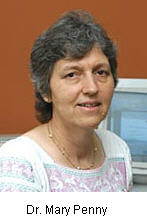An interview by Peru21 with Dr. Mary Penny, director of Peru’s Institute of Nutritional Research
By José Gabriel Chueca ——
The Institute of Nutritional Research, IIN, is one of Peru’s leading medical organizations. Founded in 1971, It is currently working on the Children of the Millennium project, as well as a vaccination campaign to prevent cervical cancer.
Dr. Mary Penny, IIN’s Director: I obtained a scholarship at Oxford to carry out pediatric research, and became interested in child diarrhea. It combined my interest for pediatrics, problems deriving from malnutrition, and microbiology although, surely, psychoanalysts would find some secret interest I don’t know about (laughs). That’s how, in 1984, I came to Lima and to the IIN, an institute very well known for its research related to these issues.
You are currently working on a vaccination campaign to prevent cervical cancer. This is one of the newest medical breakthroughs.
Cervical cancer is the primary cause of death in women aged 25-44. We now know that it is a disease that is caused by an infection triggered by the human papilloma virus, which is sexually transmitted and highly contagious. Approximately 50 to 80 percent of the world’s women will be infected by this virus in their lifetime.
How have you planned the vaccination campaign?
Our research points toward the development of public health strategies. Given that this virus is highly contagious, we have to vaccinate girls before they become sexually active to prevent infection. We have targeted 9-year old girls. It may seem early, but it is at that age that we can get to them easily, since most of them attend school. After that, drop-out rates rise. We have shared our results with Peru’s Health Ministry. We also work with Merck, Sharp & Dome, a company that has donated 1,500 doses for 500 children.
You are also working on the Children of the Millennium project. How does that work?
It began in 2000, and was launched by a group of universities based in England. It runs in Ethiopia, Peru, India and Vietnam. The project follows poverty-stricken children and their families over a long period of time, to understand what the factors are that really influence whether a children breaks free from poverty, or not.
How does it work in Peru?
We are currently working in 20 different districts that span over the entire socioeconomic spectrum, with the exception of the top five percent that corresponds to the wealthiest. We have three offices in Lima and 17 across Peru. We speak to families to determine whether they are interested in helping us and, then, we enroll children aged 6-18 months. We gather information about the family: income, spending, environment, etc. Three years later, we go back to see how the family and the child is doing. At that point, the child is approximately 4 years old. This year, we are returning for our third visit, and the child is already 8 years old.
What are you looking for?
We measure growth, enquire about his health, schooling, what has happened at home, perhaps if there has been some kind of shock, or trauma, like a divorce or separation. We ask, for example, which government programs work. If Demuna is useful to them, the wawawasis (day-care centers), food programs, or if they have access to credit or markets, etc. We want to let the government know which programs really do help.
With how many children are you working?
In Peru, we began monitoring 2,000 children when they were 1-year old. We have also monitored another group of 750 children, aged 8 when the program began. They are now 16. Worldwide, there are approximately 12,000 children being monitored.
And you cannot intervene?
Well, when we encounter very high-risk situations, we believe that something has to be done. But we tell the families that our job is not to give them medicines, or food. What we try to do is to make their reality known. They understand that, and they know that in Lima the government and the international aid agencies don’t know exactly how they live, or what they really need.
What do you hope to find?
The results will allow us to determine why, or how, a child born into poverty may have better chances of finishing school, making it to university or obtaining a good job, even though some of them have worked since they were 8 or 15 years old.
It’s odd to use your lifetime to study the lives of others. Does it make you reflect upon your own life?
Yes. Well, I am a bit of an oddball. I came to Peru to do research without ever thinking that I would stay. And I have stayed. I feel that the work we do in Peru – vaccines, diarrhea, Children of the Millennium – is important for this country and not just about research. I don’t know if I will die here (laughs), but I will continue to work at the IIN and in Peru.






